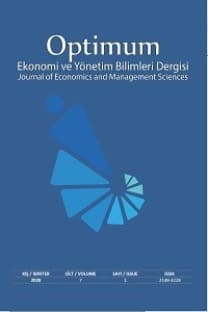2008 Krizi Sektörlerin Sistematik Riskini Etkiledi mi? Türkiye Örneği
Bu çalışma, 2008 finansal krizinin Borsa İstanbul (BIST)’da bulunan dört sektörün betaları üzerindeki etkilerini kriz öncesi, kriz ve kriz sonrası dönem olarak ayrı ayrı incelemektedir. Kriz bilgisini modele dışsal olarak dahil eden Kukla değişkenli CAPM aracılığı ile bu dört sektörün sistematik riskleri (betaları) hesaplanmıştır. Daha sonra CAPM, üç ayrı dönem (Finansal kriz öncesi, kriz dönemi ve kriz sonrası) için ayrı ayrı tahmin edilerek değişen betalar elde edilmiştir. Böylece, kriz dönemlerinde finansal yatırımcıların hangi sektör hisse senetlerinin daha riskli/güvenilir olarak algıladıkları tespit edilmiştir. Bulgular, risk iştahında bir azalış olduğu kriz dönemlerinde, hizmet sektörü hisse senetlerinin finansal yatırımcılar tarafından daha güvenilir, mali sektör hisse senetlerinin ise daha riskli olarak algılandığını göstermektedir.
Anahtar Kelimeler:
Yatırımcı Davranışı, Kukla Değişkenli CAPM, Finansal Kriz
Did 2008 Crisis Affect Systematic Risks of the Sectors? The Case of Turkey
This study examines the effects of the 2008 financial crisis on the betas of four sectors in Borsa Istanbul (BIST) separately as pre-crisis, crisis and post-crisis period. Systematic risks (betas) of these four sectors are calculated through CAPM model with the dummy variable, which includes crisis information exogenously. Afterwards, CAPM was estimated separately for three periods (pre-financial crisis, crisis period and post-crisis) and time varying betas were obtained. Thus, it was determined which sector stocks were perceived as more risky/reliable in crisis period by financial investors. Findings show that service sector stocks are perceived as more reliable and financial sector stocks are perceived riskier by financial investors in crisis period with a decrease in risk appetite.
Keywords:
Investor Behaviour, Financial Crisis, CAPM with Dummy Variable,
___
- Abiyev, V. (2015). Time-Varying Beta Risk and Its Modeling Techniques for Turkish Industry Portfolios. Economics, Business and Finance, 30 (352), 79-108.
- Celik, S. (2013). Testing the Stability of Beta: A Sectoral Analysis in Turkish Stock Market. Journal of Economics and Behavioral Studies, 5(1), 18.
- Choudhry, T. (2005). Time-varying beta and the Asian financial crisis: Evidence from Malaysian and Taiwanese firms. Pacific-Basin Finance Journal, 13(1), 93-118.
- Hammoudeh, S., & Al-Gudhea, S. (2006). Pricing Risk, Oil and Financial Factors in Saudi Sector Index Returns, Topics in Middle Eastern and North African Economies, Loyola University Chicago Loyola eCommons.
- Gujarati, D. N. (2011). Econometrics by example/Damodar Gujarati (No. 330.015195 G84.).
- Kaderli, Y., Petek, A., Doğaner, M., & Babayiğit, G. (2013). The Sensitivity to Market Index and Non-Systematic Risk Measurement of Sector Indices in Borsa İstanbul. Anadolu University Journal of Social Sciences, Vol.: 13 (3), pp. 55-64.
- Kalafatcilar, K., & Keles, G. (2011). Risk Appetite Indices and Their Expressions. Research and Monetary Policy Department, Central Bank of the Republic of Turkey.
- Kumar, Manmohan S. and Persaud, A. (2002). Pure Contagion and Investors’ Shifting Risk Appetite: Analytical Issues and Empirical Evidence, International Finance, 5 (3), pp. 401–436.
- Masset, P., & Weisskopf, J. P. (2010). Raise Your Glass: Wine Investment and The Financial Crisis. American Association of Wine Economists, Aawe Working Paper, No.57. www.wine-economics.org, Access: 02.08.2019.
- Mirza, N., & Simatupang, D. D. (2004). Comparative Systematic Risk Analysis: Evidence on the Banking Sector in the United States, Western Europe and South East Asia. The Lahore Journal of Economics, Vol. 9 (1), pp. 149-173.
- Tetik, N., & Uğur, A. (2010). Analysis of Yield Interval by Sectors in Estimating Beta Coefficient: A Research on ISE. Atatürk University Journal of Economics and Administrative Sciences, Vol. 24 (1), pp. 15-24.
- Weerakhajornsak, W. (2007). Asset Pricing in Energy Sector: The Evidence from Stock Exchange of Thailand. Master dissertation, University of the Thai Chamber of Commerce.
- Yayın Aralığı: Yılda 2 Sayı
- Başlangıç: 2014
- Yayıncı: -
Sayıdaki Diğer Makaleler
Genel Politik Etkinlik Ölçeği: Sağlık Çalışanlarında Bir Ölçek Geliştirme Çalışması
Hilal KUŞCU KARATEPE, Derya ATİK
Uluslararası B2B E-Pazarlama Gaziantep Ayakkabı Sektörüne Yönelik Bir Araştırma
Uğur YILDIZHAN, Gülçimen YURTSEVER
Fatma SÖNMEZ ÇAKIR, Zafer ADIGÜZEL
Lübnan’da Siyasal Kurumların Yeniden İnşası: Çoğunluk Sisteminden Nispi Temsile
Tahsin YAMAK, Tuba YILDIZ, Emre SAYGIN
Üniversite Öğrencilerinin Gelecekleriyle İlgili Kaygı ve Beklentilerinin Belirlenmesi
Burhanettin ZENGİN, Ümit ŞENGEL
Yabancılar ve Uluslararası Koruma Kanunu ile Göç İdaresi Bağlamında Türkiye’nin Yeni Göç Siyaseti
2008 Krizi Sektörlerin Sistematik Riskini Etkiledi mi? Türkiye Örneği
